Press Releases Archive
19.11.2014
The spatial memory process which leads Tübingen residents to their marketplace
Orientation study of passers-by suggests that a visual image of the intermediate spatial environment exists in the brain, say researchers from the University of Tübingen
When walking through the city, observers perceive and register characteristic points of orientation or divergent paths in the area from their current point of view. The brain uses this data to construct and store knowledge of the area. While long-term memory is often seen as a kind of inner or mental map, functioning independently of a person’s current location, the planning and imagined travel of routes requires a working memory taking into account the changing position of the observer. Until now, many researchers have assumed that the connection between the two memory types is produced by a kind of transformation of coordinates. This assumes, however, that the location in the brain is actually represented by explicit coordinates including a coordinate origin and metric distances. Following a study of pedestrians in Tübingen, however, Wolfgang Röhrich, Dr. Gregor Hardiess and Professor Hanspeter Mallot from the Institute for Neurobiology at the University of Tübingen suggest that another representation, based strongly upon visual representations, is involved. Their findings indicate that locations are stored in the brain simply as a collection or album of visual perspectives perceived during exploration.
In their experiments in downtown Tübingen the researchers approached pedestrians at special interviewing locations and asked them to draw a sketch of the Holzmarkt, a well-known square in the city centre. The Holzmarkt could not be seen directly from any of the interview locations. Ten interview locations were set up at a radius of some 150 meters around the Holzmarkt, and an additional four at a distance of about two kilometres from the Holzmarkt in small shopping centres. In the evaluation, only sketches by residents of Tübingen who had lived there for at least two years were used. The experiment was repeated in a comparable manner at various positions surrounding the Tübingen marketplace.
The sketches made by the passers-by at the ten nearby interview locations aligned to different compass directions. The distribution of sketch orientations of a given goal (Holzmarkt or Marktplatz) was different for different interview locations. “A more precise analysis showed that for each location, recall orientation is related to the respective direction of approach from the interview location to the goal”, says Hanspeter Mallot. The dependence of recall orientation on interview location was not found, however, at the more distant locations. The authors conclude that locations are represented in the brain as visual perspectives: the participants of the experiment recalled the Holzmarkt by means of images of the Stiftskirche (a church), or of the exits from the Holzmarkt in the direction of the Marktplatz or Schulberg. In long-term memory all of these perspectives are available but in the “working memory” only those are available, in each case, which one would see when walking towards the Holzmarkt from each specific location. “Our study data indicates that the visuo-spatial memory of places which are not directly visible at any given moment has neither a coincidental nor a fixed orientation: rather, the remembered orientation depends on both the goal and the interview location.”
The study’s results are consistent with a visual model of memory of the spatial environment in the long-term and working memory. An abstract coordinate system, as a representation of the spatial environment in the brain, thus appears unnecessary. “In our model, the problem of coordinate transformation between memory types is reduced to the selection of the specific relevant view of a location”, says the scientist.
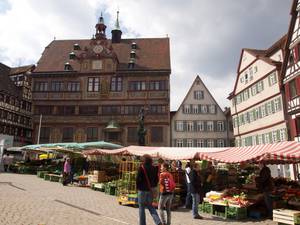 | 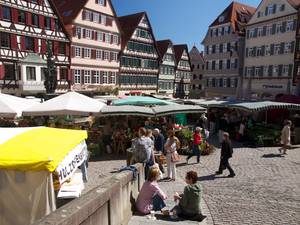 |
Tübingen‘s Marktplatz seen from the Kirchgasse, with a view of the City Hall or Rathaus (left) and from the Haaggasse (right). Photos: Friedhelm Albrecht/University of Tübingen | |
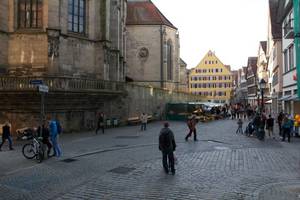 | 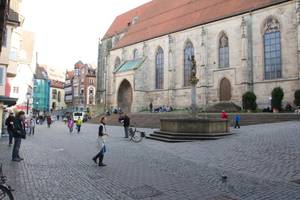 | 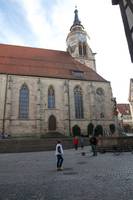 |
| Tübingen‘s Holzmarkt with the Stiftskirche church: the approach from Schulberg, that is, to the west (left), from the Kirchgasse located across the square to its east (centre) and from the Lange Gasse southwards; to the right of the church the Münzgasse turns off (right). Photos: Friedhelm Albrecht/University of Tübingen | ||
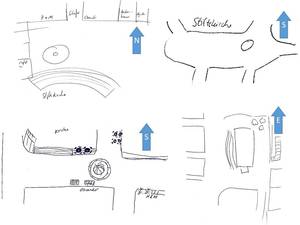 | Sample drawing of passers-by from the study. Source: PLOS ONE, PONE-D-14-29207R1 |
Publication:
Wolfgang G. Röhrich, Gregor Hardiess, Hanspeter A. Mallot: View-based organization and interplay of spatial working and long-term memories. PLOS ONE, Online publication 19 November 2014.
Contact:
Professor Dr. Hanspeter Mallot
University of Tübingen
Faculty of Science
Institute for Neurobiology – Cognitive Neuroscience
Phone: +49 7071 29-78830
<link mail ein fenster zum versenden der>hanspeter.mallot[at]uni-tuebingen.de
